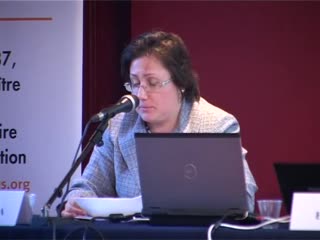
Natalia Starostina - Russian émigrés, Nostalgia and the Rise of the Myth of the Belle Epoque in Twentieth-Century France
-
Cote :
FRGNQ_V_001_003_016
-
Date :
2012
-
Description physique :
Genre/Carac. phys. : Document audiovisuel
-
Particularité du document :
Durée : 00:18:04:00
- Nature du contenu : Document audiovisuel
-
Biographie ou histoire :
Biographie ou histoire
Natalia Starostina, Ph.D., Emory '07, associate professor of history, has been teaching at Young Harris College since 2008. Her primary research investigates the history of interwar France and the construction of French identity as a multilayered phenomenon. Dr. Starostina has published articles in the Southeast Review of Asian Studies, Business History Online, Dialectical Anthropology, Real and Virtual Cities: Intertextual and Intermedial Mindscapes, The Proceedings of the Western Society for French History, The Journal of the Georgia Philological Association, Review d'histoire des chemins de fer [in French], and the edited conference proceedings Milestones in Russian History: The Materials of the International Scientific Conference [in Russian].
-
Présentation du contenu :
Présentation du contenu
« Suite à la révolution d'Octobre, de nombreux Russes ont immigré en France. Leur univers s'étant effondré avec l'ancien régime, les souvenirs de la Russie d'avant 1917 et la Belle Époque sont devenus des thèmes littéraires dominants chez les émigrés russes. Ma présentation analysera le discours nostalgique des travaux de la seconde génération d'émigrés russes, en particulier ceux de Romain Gary (1914-1980) et d'Elsa Triolet (1896-1970). »
Extrait du texte de Natalia Starostina
